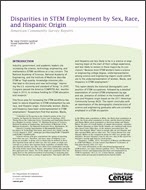Disparities in STEM Employment by Sex, Race, and Hispanic Origin
Disparities in STEM Employment by Sex, Race, and Hispanic Origin
Introduction
Industry, government, and academic leaders cite increasing the science, technology, engineering, and mathematics (STEM) workforce as a top concern. The National Academy of Sciences, National Academy of Engineering, and the Institute of Medicine describe STEM as “high-quality, knowledge-intensive jobs . . . that lead to discovery and new technology,” improving the U.S. economy and standard of living.1 In 2007, Congress passed the America COMPETES Act, reauthorized in 2010, to increase funding for STEM education and research.2
One focus area for increasing the STEM workforce has been to reduce disparities in STEM employment by sex, race, and Hispanic origin. Historically, women, Blacks, and Hispanics have been underrepresented in STEM employment.3 Researchers find that women, Blacks, and Hispanics are less likely to be in a science or engineering major at the start of their college experience, and less likely to remain in these majors by its conclusion.4 Because most STEM workers have a science or engineering college degree, underrepresentation among science and engineering majors could contribute to the underrepresentation of women, Blacks, and Hispanics in STEM employment.5
This report details the historical demographic composition of STEM occupations, followed by a detailed examination of current STEM employment by age and sex, presence of children in the household, and race and Hispanic origin based on the 2011 American Community Survey (ACS). The report concludes with an examination of the demographic characteristics of science and engineering graduates who are currently employed in a STEM occupation.
Highlights
- Women’s representation in STEM occupations has increased since the 1970s, but they remain significantly underrepresented in engineering and computer occupations, occupations that make up more than 80 percent of all STEM employment. Women’s representation in computer occupations has declined since the 1990s.
- Among science and engineering graduates, men are employed in a STEM occupation at twice the rate of women: 31 percent compared with 15 percent. Nearly 1 in 5 female science and engineering graduates are out of the labor force, compared with less than 1 in 10 male science and engineering graduates.
- The most recent decades show less growth in STEM employment among younger women. Most of the growth in women’s share of STEM employment among those under the age of 40 occurred between 1970 and 1990.
- About 41 percent of Asians with a science or engineering degree are currently employed in a STEM occupation, followed by individuals who self-identify as Two or More Races (24 percent) and non-Hispanic White (23 percent).6
- Blacks and Hispanics have been consistently underrepresented in STEM employment. In 2011, 11 percent of the workforce was Black, while 6 percent of STEM workers were Black (up from 2 percent in 1970). Although the Hispanic share of the workforce has increased significantly from 3 percent in 1970 to 15 percent in 2011, Hispanics were 7 percent of the STEM workforce in 2011.
__________
1 Committee on Prospering in the Global Economy of the 21st Century: An Agenda for American Science and Technology, 2007, “Rising Above the Gathering Storm: Energizing and Employing America for a Brighter Economic Future,” P.1, National Academy of Sciences, National Academy of Engineering, and Institute of Medicine of the National Academies, The National Academies Press, Washington, DC.
2 America Creating Opportunities to Meaningfully Promote Excellence in Technology, Education, and Science Act, Public Law No: 110-69, August 9, 2007, <www.gpo.gov/fdsys/pkg/PLAW-110publ69/pdf/PLAW-110publ69.pdf>.
3 Federal surveys now give respondents the option of reporting more than one race. Therefore, two basic ways of defining a race group are possible. A group such as Asian may be defined as those who reported Asian and no other race (the race-alone or single-race concept) or as those who reported Asian regardless of whether they also reported another race (the race-alone-or-in-combination concept). The body of this report (text, figures, and tables) shows data using the first approach (race alone). Use of the single-race population does not imply that it is the preferred method of presenting or analyzing data. The Census Bureau uses a variety of approaches. This report will refer to the White-alone population as White, the Black-alone population as Black, the Asian-alone population as Asian, and the American Indian and Alaska Native-alone population as American Indian and Alaska Native. Because of a small number of sample observations, estimates for Native Hawaiian or Other Pacific Islander are combined with those who report Some Other Race. In the analyses presented here, the term “non-Hispanic White” refers to people who are not Hispanic and who reported White and no other race. The Census Bureau uses non-Hispanic Whites as the comparison group for other race groups and Hispanics. Because Hispanics may be any race, data in this report for Hispanics overlap with data for racial groups.
4 Amanda L. Griffith, 2010, “Persistence of Women and Minorities in STEM Field Majors: Is It the School That Matters?” Economics of Education Review 29(6): 911–922.
5 For more information on the educational background of STEM workers, see Liana Christin Landivar, 2013, “The Relationship Between Science and Engineering Education and Employment in STEM Occupations,” ACS-23, U.S. Census Bureau, available at <www.census.gov/topics/employment/industry-occupation/library/publications.html>.
6 The estimates for Two or More Races and non-Hispanic White are not statistically different.
Related Information
Others in Series
Publication
Publication
Publication





